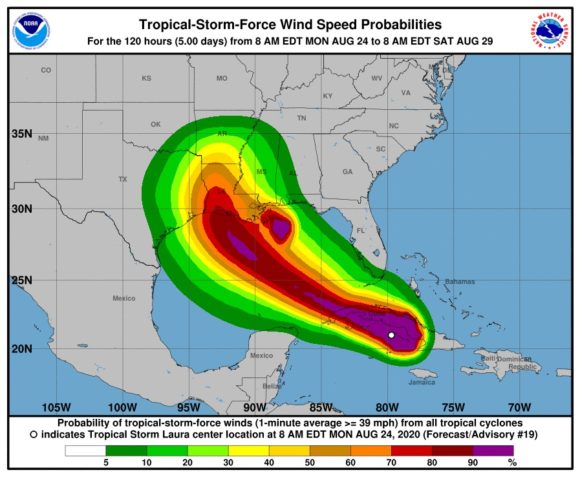Leaders on the U.S. Gulf Coast warned Monday that Tropical Storm Laura could rapidly intensify into one of the most powerful hurricanes to hit the region and urged residents to prepare before landfall in Texas or Louisiana expected in the next 48 hours.
Anticipating deadly winds, rains and storm surges, the governor of Louisiana told citizens that Laura could rival 2005’s Hurricane Rita, one of the fiercest recorded in the Gulf.
Laura comes on the heels of Tropical Storm Marco, which weakened sooner than expected and made landfall on Monday in Louisiana. Forecasters predicted Marco would become a tropical depression in the evening.
The rare threat of two possible hurricanes in the Gulf at once prompted energy companies to shutter operations and ride out the weather, taking nearly 10% of the United States’ crude oil production offline.
Storm Surges
The National Hurricane Center warned that Laura could bring potentially deadly storm surges from San Luis Pass, Texas, to Ocean Springs, Mississippi, in the next two days.
The mayor of Port Arthur, Texas, an oil town of 54,000 people 85 miles (137 km) east of Houston, ordered a mandatory evacuation, giving residents until 6 a.m. on Tuesday to leave. Several other cities asked for voluntary evacuations.
Lina Hidalgo, the chief executive of Harris County, which includes Houston, urged residents to be prepared and not “to get cocky” by failing to prepare for the worst.
“We’re leaving no stone unturned with our preparation. Now it is your turn,” Hidalgo told a news conference.
While underscoring the need for preparation, Houston Mayor Sylvester Turner added Laura was not expected to stall over the region and dump as much rain as Hurricane Harvey in 2017, which led to deadly flooding.
In Louisiana, Governor John Edwards implored people to take advantage of the sudden weakening of Marco to ready for Laura.
“This has the potential to be the strongest hurricane to hit since Hurricane Rita,” Edwards said at a Monday evening news conference, referring to the Category 5 hurricane that hit in 2005.
Howling Winds
Laura traced the southern coast of Cuba on Monday, but the brunt of the storm was offshore, helping the largest island nation in the Caribbean avoid serious damage after Laura killed at least 10 people in Haiti and the Dominican Republic.
Laura was heading toward the Gulf of Mexico at 20 miles per hour (31 kilometers per hour) and likely would enter the gulf overnight, according to the NHC.
The storm was predicted to reach hurricane strength by Tuesday then strengthen further before hitting the U.S. Gulf Coast by Wednesday night, the NHC said.
By then, it could be a Category 2 or 3 hurricane on the 5-step Saffir-Simpson scale for measuring hurricane intensity, said Chris Kerr, a meteorologist at DTN, an energy, agriculture and weather data provider.
Covid Complications
Despite Marco’s weakening, the storm still threatened to soak the Louisiana coast.
This year’s hurricane season has been complicated by the coronavirus pandemic, forcing many people to weigh the risks of leaving their homes and potentially exposing themselves to the virus.
Officials in Louisiana said that testing for COVID-19 was suspended in the state on Monday and Tuesday.
Energy companies moved to cut production at U.S. Gulf Coast oil refineries after shutting half the area’s offshore crude oil output.
Producers have shut more than 1 million barrels per day of Gulf Coast offshore oil production, 9% of the nation’s total output.
(Reporting by Jonathan Allen and Maria Caspani in New York, Marc Frank in Havana, Kate Chappell in Kingston and Brad Brooks in Lubbock, Texas Editing by Matthew Lewis and Cynthia Osterman)
(Reporting by Jonathan Allen in New York, Marc Frank in Havana and Kate Chappell in Kingston Editing by Matthew Lewis)
Related:
- Dueling Storms Marco, Laura Hit Haiti, Dominican, Cuba on Way to Gulf Coast
- Gulf Coast Braces for Tropical Storm Marco; States Declare Emergencies
Topics Catastrophe USA Natural Disasters Texas Windstorm Louisiana Energy Oil Gas Hurricane
Was this article valuable?
Here are more articles you may enjoy.



 Harvard Study Again Stirs the Pot on Demotech Ratings of Florida Carriers
Harvard Study Again Stirs the Pot on Demotech Ratings of Florida Carriers  JPMorgan Client Who Lost $50 Million Fortune Faces Court Setback
JPMorgan Client Who Lost $50 Million Fortune Faces Court Setback  California Chiropractor Sentenced to 54 Years for $150M Workers’ Comp Scheme
California Chiropractor Sentenced to 54 Years for $150M Workers’ Comp Scheme  Undercover St. Louis Officer Beaten by Colleagues Awarded $23.5M
Undercover St. Louis Officer Beaten by Colleagues Awarded $23.5M 

